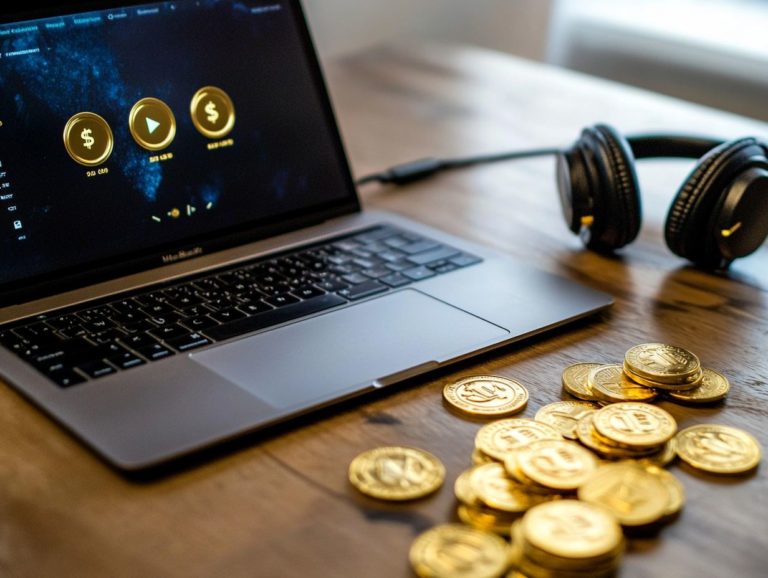5 Questions to Ask Before Investing in Gold
Investing in gold can indeed be an enticing opportunity, but it s vital for you to approach it with a well-defined strategy.
Get ready to uncover vital insights on gold investment! This exploration delves into five crucial questions that will aid you in navigating the complexities of gold investment. You ll learn how to define your investment goals, understand the various forms of gold investment, and assess market trends alongside potential risks.
The discussion also addresses tax implications, authenticity checks, and common pitfalls to steer clear of, ensuring you have a comprehensive understanding before making any decisions.
Whether you re a seasoned investor or just starting out, this guide equips you with the essential knowledge needed to make informed choices about gold.
Contents
- Key Takeaways:
- 1. What Are My Investment Goals?
- 2. What Are the Different Forms of Gold Investment?
- 3. What Is the Current Market Trend for Gold?
- 4. What Are the Risks Involved in Investing in Gold?
- 5. What Are the Tax Implications of Gold Investment?
- How Can I Determine the Authenticity of Gold?
- Frequently Asked Questions
- What is the importance of asking questions before investing in gold?
- What are the five questions to ask before investing in gold?
- What is the current market trend for gold?
- What are the different ways to invest in gold?
- What are the risks involved in investing in gold?
- What are the fees and charges associated with gold investments?
- What is the long-term potential of gold as an investment?
Key Takeaways:

1. What Are My Investment Goals?
Establishing clear investment goals is crucial for retail investors. These goals serve as a compass, guiding your selection of options and strategies, impacting your portfolio performance.
By defining your aspirations be it keeping your wealth safe, capital gains, or a safeguard against inflation you can tailor your investment strategies to align with your personal financial objectives while weighing the opportunity cost of various allocations.
Understanding how to pinpoint your personal investment goals shapes these objectives and ensures they resonate with your long-term aspirations. If your focus is on keeping your wealth safe, you ll prioritize protecting your existing assets against inflation and market volatility.
If you re targeting capital gains, your attention will shift towards growth through calculated investments in stocks or real estate. You need effective risk management to balance potential returns with acceptable risk.
Each goal you set will inform the necessary degree of diversification within your portfolio, guiding your selection between high-risk opportunities and more stable investments to achieve the right balance.
2. What Are the Different Forms of Gold Investment?
Investing in gold presents you with a wealth of options, each tailored to fit your unique preferences and financial objectives. From the classic allure of physical gold think bullion bars and coins to modern alternatives like gold ETFs and allocated or unallocated gold accounts, understanding these choices enables you to strategically weave gold into your investment portfolio.
This approach helps diversify your investments and navigate market volatility while working to preserve your wealth.
Tangible assets such as gold coins and bars deliver intrinsic value and act as a dependable hedge against inflation. Gold ETFs (Exchange-Traded Funds) and exchange-traded products (ETPs) offer enhanced liquidity and streamlined management. For instance, gold ETFs track gold prices and can be traded on stock exchanges, providing a cost-effective means of exposure without the burdens of storage and insurance.
Conversely, investing in gold bars or coins might come with premiums influenced by market fluctuations and rarity, yet they also grant you a comforting sense of security. To better understand the landscape, it’s essential to be aware of the top 10 gold investment myths debunked. Each form of gold investment not only bolsters a balanced portfolio but plays a crucial role in effective risk management, allowing you to adapt your strategies in response to shifting market conditions.
3. What Is the Current Market Trend for Gold?
The current market trend for gold reveals a sophisticated interplay of global economic conditions, inflation rates, and investor sentiment. This positions gold as a pivotal asset for you as a retail investor navigating unpredictable financial waters.
As precious metals gain prominence as safe-haven assets during economic turmoil, grasping the nuances of gold price fluctuations and its historical value is essential for making informed investment choices.
In recent months, rising inflation has led you to reassess how you divide your investments, often leaning towards gold as a safeguard against diminishing purchasing power. The volatility in the stock market amplifies this trend, prompting you to seek stability in tangible assets.
By analyzing historical gold price patterns, you can gain valuable insights into current trends. This may assist you in anticipating future movements. Understanding how past economic events have shaped gold values allows you to make educated predictions, ultimately refining your investment strategies in a swiftly evolving market landscape. For those considering gold, here are 5 considerations for international gold investments that can further guide your decisions.
4. What Are the Risks Involved in Investing in Gold?
Investing in gold may be a reliable shield against market volatility. However, recognizing the inherent risks that accompany this choice is crucial.
As an investor, you’ll need to consider factors like market price fluctuations, the premium cost of physical assets, and the opportunity costs tied to gold versus other investment avenues. Thorough due diligence is key here.
You might also face liquidity issues, especially when it comes time to sell physical gold. It’s not always as straightforward as trading stocks or bonds. For those new to this market, here are 5 gold investment FAQs answered. Unlike equities, gold doesn’t generate any income, which means you could miss out on potential returns from other investments.
Given how quickly market conditions can change, staying informed and adaptable is essential for you. A well-rounded strategy that includes a diverse mix of asset classes can help mitigate these risks, ensuring a balanced approach to your wealth accumulation journey.
5. What Are the Tax Implications of Gold Investment?

Understanding the tax implications of gold investment is essential for you as a retail investor. It can significantly impact your overall returns and investment strategies, particularly concerning capital gains and potential taxation on transactions involving precious metals.
Be aware of the regulations surrounding gold investments to ensure compliance and maximize your wealth preservation efforts through informed financial advice.
The intricacies of capital gains tax can differ based on whether you hold physical gold, such as coins and bullion, or invest in gold exchange-traded funds (ETFs) and mining stocks. Generally, gains from selling physical gold are taxed at higher long-term capital gains rates if held for over a year, while short-term holdings might attract ordinary income tax rates.
Different jurisdictions come with their own rules regarding the sale and storage of gold, complicating matters further. This complexity highlights the importance of engaging with financial advisors who are well-versed in tax strategies and can guide you on how to start investing in gold safely.
Consider consulting a financial advisor to navigate these complexities effectively. By doing so, you can ensure that your investment decisions align with your financial goals and obligations, helping to mitigate any unforeseen liabilities.
How Can I Determine the Authenticity of Gold?
Determining the authenticity of gold is crucial for you as an investor. Ensuring that you acquire genuine precious metals is key, especially since counterfeit products can significantly undermine the value of your investment portfolio and overall financial security.
To safeguard yourself against fraud, consider using methods like assay testing a process to check if gold is real obtaining certifications from reputable sources, and conducting thorough market research. These steps bolster your due diligence efforts.
Seek certifications from recognized authorities like the Perth Mint or the World Gold Council. These credentials provide assurance about the purity and legitimacy of the metal you are purchasing, offering a dependable foundation for informed decisions.
Buying gold from well-established dealers provides more protection. Reputable firms are far more likely to sell authentic products. Before making any investment decisions, consider the 5 questions to ask before investing in silver. By prioritizing consumer protection and exercising careful diligence, you can navigate the complexities of the gold market with increased confidence and security in your investments.
What Are the Factors That Affect the Price of Gold?
The price of gold is influenced by several factors, including market conditions, inflation rates, and global economic uncertainty. It’s crucial for you, as a retail investor, to understand these dynamics to make well-informed decisions. Gold has long been recognized as a valuable asset and a safe haven during turbulent times. Therefore, fluctuations in its price can significantly impact your investment strategies and portfolio performance.
Economic indicators like interest rates and currency strength play vital roles in shaping gold’s allure. When interest rates rise, the dollar often strengthens, which can diminish the appeal of holding gold. Conversely, during inflationary periods, gold tends to maintain its purchasing power, attracting investors who seek stability.
Additionally, geopolitical tensions can trigger market volatility, leading to a rush toward gold and influencing its price. Understanding these interwoven factors makes you a smarter investor, allowing you to adjust your strategies accordingly.
What Are the Common Mistakes to Avoid When Investing in Gold?
Retail investors often encounter common missteps when venturing into gold investing. Neglecting due diligence, failing to diversify, and misjudging market conditions can jeopardize your financial goals and overall investment strategy. Being aware of these pitfalls is essential for effective risk management and achieving long-term success.
To mitigate these risks, conduct thorough research before making any asset purchases. Dive into historical price trends and monitor the news affecting the gold market. For those looking to invest wisely, following the 5 steps to investing in gold responsibly can provide valuable insights into potential price movements, enabling you to strategize effectively.
Diversifying not only within gold but also across various asset classes can significantly reduce your risk exposure. By spreading your investments across multiple sectors or commodities, you can buffer against unforeseen market fluctuations, leading to a more stable and fruitful investment experience.
What Are the Different Ways to Invest in Gold?
You have a wealth of options when it comes to investing in gold, ranging from physical assets like gold bars and coins to financial instruments such as gold Exchange-Traded Funds (ETFs) and accounts that let you own specific amounts of gold or just a share of it. Each of these choices presents its own set of benefits and risks, making it essential for you to grasp the nuances of these formats to craft a well-rounded investment strategy that aligns with your goals and the current market climate.
These alternatives cater to various preferences and risk appetites, allowing you to tap into gold’s historical value retention. For example, physical gold offers a tangible sense of security and serves as a hedge against inflation, but it also comes with the responsibilities of storage and insurance, which add to your overall costs. On the flip side, gold ETFs offer liquidity and are easy to trade, appealing to those who prefer a more hands-off approach. Just keep in mind the management fees and the fact that you won’t have physical possession of the asset. Additionally, consider the 5 signs of a good gold investment opportunity to make informed decisions.
With each option carrying different implications for long-term investment outcomes, you should evaluate how gold fits into your overall financial plan by considering 5 tools for evaluating gold investment risks.
How Can I Diversify My Gold Investment?

Diversifying your gold investment is a savvy strategy to boost your overall portfolio performance and reduce risks tied to market volatility. By capitalizing on various forms of gold, you can effectively balance how you divide your money among different types of investments. Consider combining physical gold with gold ETFs or mining stocks; this creates a robust investment strategy tailored to your financial aspirations.
Incorporating a mix of gold-related assets not only protects you against inflation but also positions you to reap the benefits of potential price appreciation. For example, while tangible assets like bullion and coins carry intrinsic value, financial products such as options and futures offer flexibility and leverage. Following the 5 best practices for gold investing can enhance your strategy. Investing in gold mining companies can yield gains that may surpass those of physical gold during market recoveries.
This layered approach enables you to manage risk through diversification, ensuring that an unexpected downturn in one area can be counterbalanced by stability or growth in another.
What Are the Long-Term Prospects for Gold Investment?
The long-term outlook for your gold investment remains quite promising. Many analysts regard gold as a steadfast inflation hedge and an effective means of preserving wealth, especially in times of market fluctuations and economic uncertainty.
As the global financial landscape shifts, it’s essential for you to evaluate various performance metrics to understand gold’s lasting value and its integral role in a well-rounded portfolio, especially by considering key factors for gold investments.
Historically, gold has proven its ability to maintain value over time, often outshining other assets during economic upheavals. For instance, during significant market downturns, this precious metal remains appealing, making it a top pick for those who prefer a more conservative investment approach.
Research shows a strong correlation between gold prices and inflation rates, reinforcing its reputation as a protective asset.
Analysts consistently highlight that diversification including gold can significantly reduce risk, allowing you to navigate economic uncertainties with greater resilience and informed confidence.
Frequently Asked Questions
What is the importance of asking questions before investing in gold?
Asking questions before investing in gold is essential because it helps you understand the market and make informed decisions. It also ensures that you don’t fall into common traps and scams in the gold investment industry.
What are the five questions to ask before investing in gold?
The five questions to ask before investing in gold are:
- What is the current market trend for gold?
- What are the different ways to invest in gold?
- What are the risks involved in investing in gold?
- What are the fees and charges associated with gold investments?
- What is the long-term potential of gold as an investment?
What is the current market trend for gold?

The current market trend for gold depends on factors like global economic stability, inflation, and demand. Researching these trends is essential before investing.
What are the different ways to invest in gold?
You can invest in gold in various ways: physical gold like coins and bars, exchange-traded funds (ETFs), futures, and mining stocks. Each option carries different risks and rewards.
What are the risks involved in investing in gold?
Investing in gold comes with risks, such as market fluctuations and political issues. It’s vital to research these before making decisions.
What are the fees and charges associated with gold investments?
Fees vary by investment method. For instance, physical gold may incur storage and insurance fees, while ETFs charge management fees. Understanding these costs is crucial.
What is the long-term potential of gold as an investment?
Gold has a track record of stability and can be a smart hedge against inflation. Remember, past performance doesn’t guarantee future results, so stay informed!
Start your gold investment journey today and secure your financial future!















